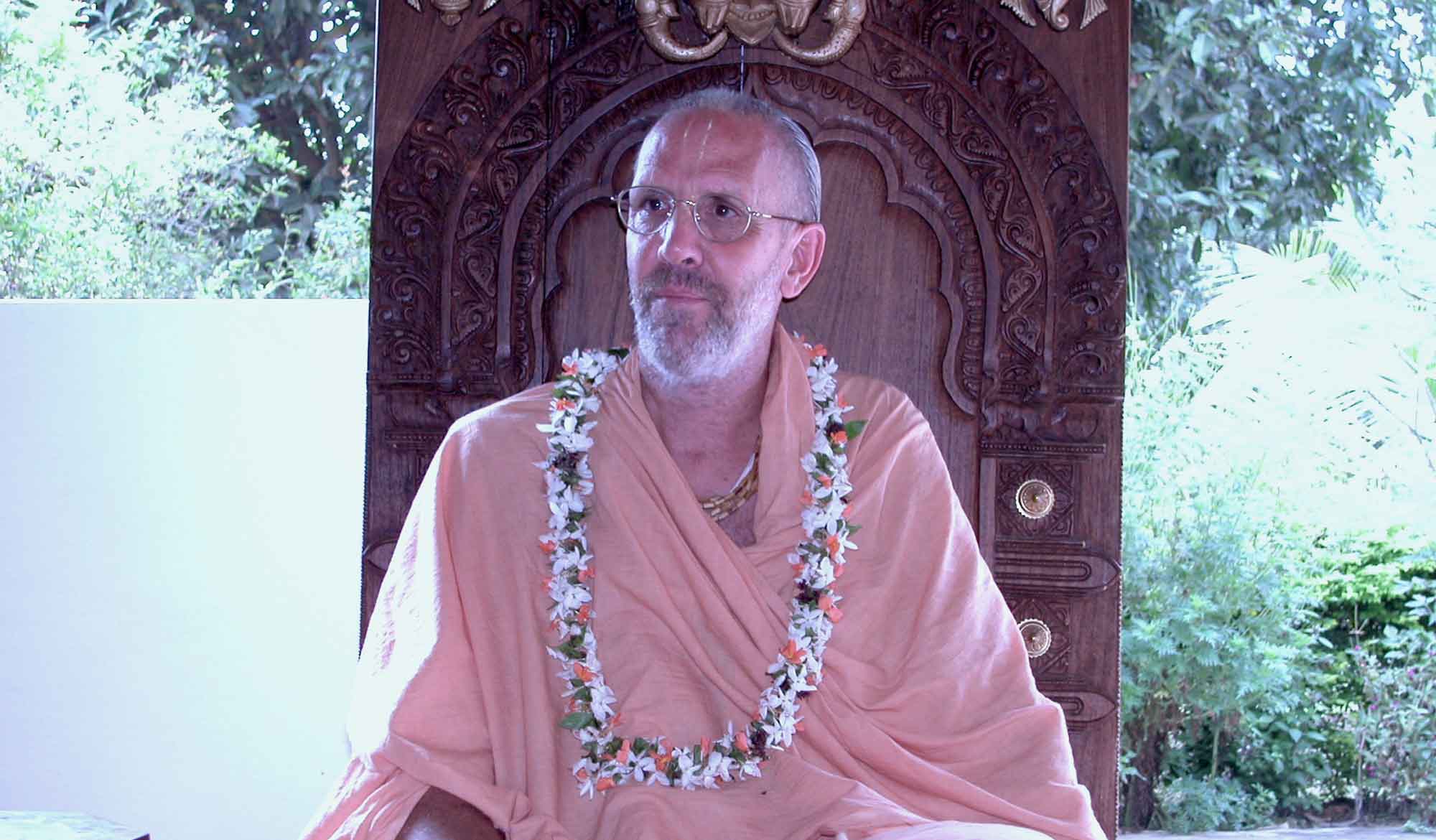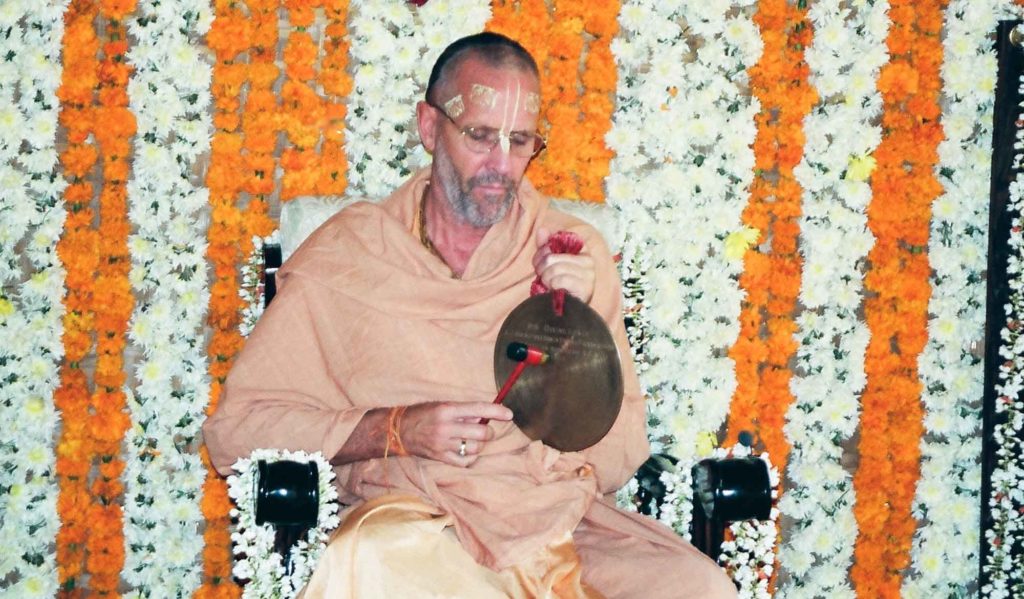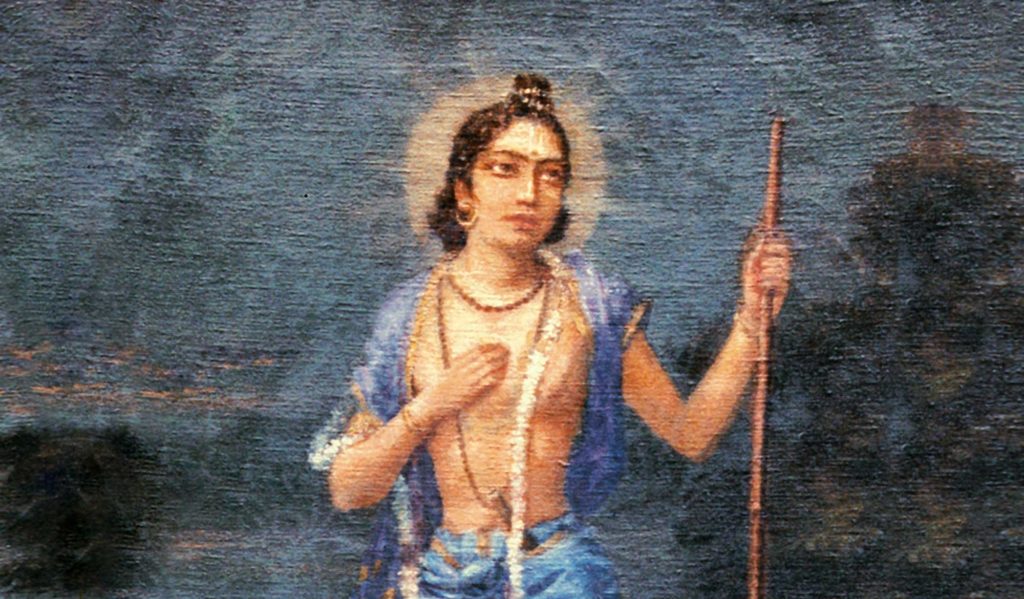Overview
“Go Deeper!” was written by Śrīla Narasiṅgha Mahārāja in 2002. In this article Narasiṅgha Mahārāja encourages his readers to dive deeper into bhakti and enter into its inner meanings, even in so-called ‘ordinary’ devotional activities.
There is a lot of history to our paramparā. We cannot simply speak substantially on topics of Kṛṣṇa Consciousness according to our whim, because it is always under lock and key. The keeper of the key is above us. According to His wish, a dumb man can eloquently speak the Vedas, or a blind person can see the beauty of the Himalayas, or a lame man can cross mountains. Actually it is in His hands. When Śrīla Bhaktisiddhānta Sarasvatī Ṭhākura sent the first devotees to the west for preaching, he told them, “Go forth with this message of Śrīman Mahāprabhu, and listen very closely to what you say.”
Sarasvatī Ṭhākura used the words ‘subjective reality,’ ‘subjective experience’ and ‘subjective plane’ to describe various aspects of the philosophy of Kṛṣṇa Consciousness. What they were after, what they were trying to get in touch with, was reality descending, coming down to the proper recipient. So his conception of preaching was that in the authorized speaker in front of a bona-fide audience, things that neither one has ever heard before may descend through the speaker. This is not the type of thing that we can easily understand, but as we go on and discuss, you will see that this is something that we have been a part of since the beginning. In another very simple way, Śrīla Prabhupāda said, “I did not write these books, Kṛṣṇa did.” Vyāso-vetti na vetti vā.
But what did he mean, “Kṛṣṇa wrote these books?” In Caitanya-caritāmṛta, Rāmānanda Rāya tells Mahāprabhu, “What I am saying is simply passing through me; I do not even know if it is correct or not.” Everything was revealed in the heart of Brahmā at the beginning of creation in the same manner. Tene brahma hṛdā ya ādi-kavaye. Rāmānanda Rāya tells Mahāprabhu, “You also are causing me to speak, and it is passing through me. It is wonderful, but I am not sure if it is even right, only You the listener, you will be able to say if it is right or not.”
The subjective experience of Kṛṣṇa Consciousness is coming down to us through the guru; it is coming to us through the agency of our guru. In the beginning, we do not generally have any qualification to draw down Kṛṣṇa; we are like a dead battery that cannot draw the radio message. With some force, the agent of Kṛṣṇa turns up the volume and blasts out the message, almost to the point that even the deaf can hear it, and respond. But what must happen is that the hearer must become alive in that plane, and eager for that message. The message is infinite. When the first devotees were sent to the western world for preaching, in 1933, heading that group of devotees was Bhakti Hṛdaya Vana Mahārāja, who was the second or third sannyāsī disciple of Śrīla Bhaktisiddhānta. Śrīla Bhaktisiddhānta had only eighteen sannyāsī disciples. Our Śrīla Prabhupāda had fifty-seven, and some of Śrīla Prabhupāda’s godbrothers had over one hundred. Śrīla Purī Mahārāja had one hundred and twenty-seven sannyāsī disciples.
Śrīpāda Vana Mahārāja was amongst Śrīla Bhaktisiddhānta’s sannyāsī disciples, and he headed the first group of devotees to the west; they went to England. This is pre-World War II, in 1933. Many of the prominent (and at that time respected) personalities in World War II were also there at that time. Vana Mahārāja met Goebbels and Rommel, and distributed a book called Shree Krishna Chaitanya. I have a copy of that book; it has been out of print for a long time. It’s about eight hundred pages, and it is in par-excellent English. Nishikant Sanyal, Prabhupāda’s godbrother, wrote it, and there is an elaborate introduction by Śrīla Bhaktisiddhānta himself. When that book was ready, Śrīla Bhaktisiddhānta announced, “Now we are ready for preaching in the west.”
When the devotees were sent to England, there was a very formal function in Calcutta, Śrīla Bhaktisiddhānta said to his disciples, “Go forth with this message of Mahāprabhu to all nations and all creeds of men and women in the world; carry forth this message, preach it boldly, and listen to what you say, for this will also purify you.” With this he sent them out into the world for preaching.
Only so much knowledge of Godhead can be learned by any living entity. The message is broadcast vigorously and then a living entity has to turn his head with submission towards that message. Once the initial message finds its place in the heart, then we may draw more and more. It is actually our eagerness in the first place to know Who is God, which brings guru into our midst. It is said, that if you try to find a guru on you own, you will most likely accept someone who gives you a rasagulā.
What the ācāryas tell us is that the living entity cannot “find a guru,” but rather, acceptance of guru is a descending process. We cannot ascend to the plane of the guru, but it is by his mercy that we may have contact with him. We may conduct our search, and that is how we exhibit our sincerity. Our search is there, but one can never find guru independently; he is only revealed. Therefore, even if someone has accepted a guru, but the guru goes away in devotional service, that person should not feel any hardness, any resentment towards that person. One should not feel cheated. One should rather feel that “I received what I deserved.” If you examine without prejudice, you may find, although your guru may have gone away, that you gained something from that relationship. You may find that there is some little thing to help you, any small thing. Then you may say, “Yes, I received something,” and be happy with it. Having made a step in the right direction, you may then go on with your earnestness, and pray to Kṛṣṇa, and he will send you further guidance. If you blame even that fallen guru, you are blaming Kṛṣṇa, saying, “There is nothing wrong with me, I deserve the best; why am I cheated?” That approach is very self-centred, and self-centeredness distances us from divinity.
Rather, we should understand that, “the only defect is in me.” This will align us with divinity, and the clouds of so much confusion and misunderstanding will go away, and the sun of Kṛṣṇa will shine bright in our life. No one is cheated in this world; every one is a self-deceiver, and a self-cheater. There is no one to blame; it is not healthy to blame the environment. It is healthier to blame one’s own self, for in doing so we leave room within ourselves for self-improvement. This is one of the keys on the ring of the secrets of how to progress: do not blame others, blame yourself!
Our sampradāya is a descending process, not an ascending process. This has to be kept in mind always. The more you keep this in mind, and try to put it into normal practice, the more it becomes a reality, rather than a dry theory. We are in control of nothing; Kṛṣṇa controls everything. Grace is coming to us; He is everywhere, and He is behind everything. For example, you cannot actually serve yourself prasādam, unless you are just really hungry and must go do your service. Prasādam means mercy, and mercy is descending. You cannot conjure your own mercy. Of course, we know that in informal gatherings, we do practical things — we have a way that devotees go and take prasādam, and that is not a problem. But you add all these things together, there are many little things, and suddenly that living conception of everything is descending, it is gone, it vanishes, and then it is only a theory.
In this connection, consider Arjuna, who could not put on his own armour. If he picked up his armour and put it on, and sheathed his own sword for battle, it was all useless, because these things were benedictions given to him. They required that he had to be dressed in his armour. So we are like Arjuna also, in that sense; many things are given to us, but we have to receive them in a proper way. You cannot receive gāyatrī mantra independently; you cannot give it to yourself. You cannot take sannyāsa; it is something that is given. We receive initiation, we do not take it, we do not take prasādam, we must receive it and honour it.
I have had a very pluralistic experience in Kṛṣṇa Consciousness in the last fifteen years. I have spent many days, many months in the āśramas of some of the senior godbrothers of Śrīla Prabhupāda; Śrīla Śrīdhara Mahārāja, and Śrīla Bhakti Pramoda Purī Mahārāja. There I saw, heard, and learned many things; some things on a very practical, day to day level, and some things on a very high philosophical level. So one day many years ago, a devotee came to the āśrama of Śrīla Śrīdhara Mahārāja. He was a Prabhupāda disciple from South America. He wanted to receive sannyāsī, so there was some talk, then Śrīla Śrīdhara Mahārāja told him, “You stay here for some time, and we will see. Try to do some menial service here in the maṭha.”
Then with a happy heart, that devotee went to do some menial service. He went to the prasādam hall, grabbed a bucket and a spoon and started serving prasādam. One of the older devotees, who had been in the āśrama for fifty years, came over and asked, “What are you doing?” He replied, “Oh, I am serving prasādam. Guru Mahārāja told for me to serve prasādam,” the man said, “What did he tell you?” “Guru Mahārāja told me to do some menial service.” The older devotee said, “This is not menial service; menial service means sweeping the cow barn. Serving prasādam is very high.
Who can give the mercy of Kṛṣṇa. A new devotee can be engaged in serving prasādam, he is serving prasādam by carrying it to the devotees, but what will you value more, prasādam given by a new devotee, or prasādam given by your guru’s hand? Same prasādam, same offering, same Kṛṣṇa’s plate, but you will value the prasādam given by your guru’s hand more than the prasādam given by the new devotee. The giver of the prasādam is also in that line, that mercy line, and he is an important factor. Mercy is descending.
There are many subtle practices in our spiritual tradition. Sometimes one practice or another may be omitted or dealt with subconsciously due to some practical necessity, but this may eventually become a problem. Over the years, many simple practices in Kṛṣṇa consciousness have been left aside in the name of practical necessity — then gradually, the conception of what we are actually dealing with slips away. This should be checked and we should try to deepen our understanding about even the simplest of practices that we perform.
High devotion does not necessarily mean that it must always be the discussions of kṛṣṇa-līlā. High devotion also means understanding what is prasādam and similar such things that we have come to take for granted. High devotion means to understand the inner meaning, or the substance of all the practices in Kṛṣṇa consciousness. What is serving prasādam, what is serving the Deity, and so forth. All these seemingly simple ordinary daily practices are not really ordinary at all; they are divine activities with a deep connection in the spiritual world of eternal pastimes of the Supreme Lord. Therefore, we should endeavour to make our most sincere attempt to go deeper into even that which is seemingly the most insignificant thing in Kṛṣṇa consciousness.
Related Articles & Books
- Vaiṣṇava Nindā by Śrīla Bhaktivinoda Ṭhākura
- A Devotee is Merciful (Sajjana – Kṛpālu) by Śrīla Bhaktisiddhānta Sarasvatī Ṭhākura
- A Devotee Does Not Engage in Violence (Sajjana – Akṛta-droha) by Śrīla Bhaktisiddhānta Sarasvatī Ṭhākura
- A Devotee is the Epitome of Truth (Sajjana – Satya-sāra) by Śrīla Bhaktisiddhānta Sarasvatī Thākura
- Śiva-tattva & the Position of Lord Śiva by Śrīla B.R. Śrīdhara Mahārāja
- Oh Bābā! Bolacche-re! by Śrīla B.R. Śrīdhara Mahārāja
- Problems and Solutions by Śrīla B.R. Śrīdhara Mahārāja
- The Highest Attainment and Present Adjustment by Śrīla B.R. Śrīdhara Mahārāja
- Āgun Jvālbe (Light the Fire!) by Śrīla B.R. Śrīdhara Mahārāja
- Dharma and the Modern World by Śrīla A.C. Bhaktivedānta Swami Prabhupāda
- Faith Confirms the Absolute by Śrīla B.G. Narasiṅgha Mahārāja
- Go Deeper! by Śrīla B.G. Narasiṅgha Mahārāja
- To Be a Servant by Śrīla B.G. Narasiṅgha Mahārāja
- Harmony – Real and Apparent by Swami B.V. Giri
- The Definition of Faith by Gaura Gopāla Dāsa
- Ātma Samīkṣā – The Value of Introspection by Kalki Dāsa
- Frogs in the Well of Prejudice by Kalki Dāsa
Further Reading
- Śraddhā (Faith) – Quotes by Bhaktivinoda Thakura
- Śraddhā and Śaraṇāgati by Śrīla Bhaktivinoda Ṭhākura
- The Association of Sādhus by Śrīla Bhaktivinoda Ṭhākura
- Epilogue to Śrī Kṛṣṇa Karṇāmṛta by Śrīla Bhaktivinoda Ṭhākura
- Prīti (Love) by Śrīla Bhaktivinoda Ṭhākura
- A Dispute Concerning Mahāprasāda by Śrīla Bhaktivinoda Ṭhākura
- Śraddhā by Śrīla Bhaktivinoda Ṭhākura
- Materialistic Association by Śrīla Bhaktivinoda Ṭhākura
- Dispelling Doubts by Śrīla Bhaktivinoda Ṭhākura
- The Enemy by Śrīla Bhaktivinoda Ṭhākura
- A Critique of the book ‘Vanamālā’ by Śrīla Bhaktivinoda Ṭhākura
- Kali by Śrīla Bhaktivinoda Ṭhākura
- Offences Against Bhakti by Śrīla Bhaktivinoda Ṭhākura
- Kārttika-vrata by Śrīla Bhaktivinoda Ṭhākura
- Violence and Mercy by Śrīla Bhaktivinoda Ṭhākura
- Abandoning Bad Association by Śrīla Bhaktivinoda Ṭhākura
- Sad-guṇa and Bhakti by Śrīla Bhaktivinoda Ṭhākura
- The Process of Initiation by Śrīla Bhaktivinoda Ṭhākura
- Dainya (Humility) by Śrīla Bhaktivinoda Ṭhākura
- Vaiṣṇava Nindā (Offences to Devotees) by Śrīla Bhaktivinoda Ṭhākura
Pilgrimage with Swami Narasiṅgha – Part 7: Keśī Ghāṭa
Continuing with our pilgrimage series, this week Śrīla Narasiṅgha Mahārāja takes us to Keśī Ghāṭā where he tells us about Madhumaṅgala’s meeting with the Keśī demon, what Keśī represents, and how Śrīla Prabhupāda almost acquired Keśī Ghāṭa. Mahārāja also narrates his own experience. This article has been adapted from a number of talks and articles by Narasiṅgha Mahārāja.
Prema Dhāma Deva Stotram with the Narasiṅgha Sevaka Commentary – Verses 61-65
In verses 61 to 65 of 'Prema Dhāma Deva Stotram', Śrīla Śrīdhara Mahārāja narrates the pastime of Śrī Caitanya at Caṭaka Parvata In Purī and explains how the scriptures produced by Brahmā and Śiva are ultimately searching for the personality of Mahāprabhu who is merciful too all jīvas, no matter what their social position.
Prabhupāda Śrīla Sarasvatī Ṭhākura’s Visit to Ayodhyā
With the forthcoming observance of Śrī Rāma Navamī, we present 'Prabhupāda Śrīla Sarasvatī Ṭhākura’s Visit to Ayodhyā' written by Śrīla Bhaktisiddhānta Sarasvatī Ṭhākura Prabhupāda from The Gaudīyā magazine, Vol 3. Issue 21/ In December 1924, after visiting Benares and Prāyāga, Sarasvatī Ṭhākura visited the birth-site of Śrī Rāmācandra in Ayodhyā.
Śaraṇāgati – The Only Path to Auspiciousness
In this article, 'Śaraṇāgati - The Only Path to Auspiciousness', Dhīra Lalitā Dāsī analyses the process of śaraṇāgati (surrender) beginning with śraddhā (faith). She also discusses the role of śāstra and the Vaiṣṇava in connection with surrender.
Pilgrimage with Swami Narasiṅgha – Part 7: Keśī Ghāṭa
Continuing with our pilgrimage series, this week Śrīla Narasiṅgha Mahārāja takes us to Keśī Ghāṭā where he tells us about Madhumaṅgala’s meeting with the Keśī demon, what Keśī represents, and how Śrīla Prabhupāda almost acquired Keśī Ghāṭa. Mahārāja also narrates his own experience. This article has been adapted from a number of talks and articles by Narasiṅgha Mahārāja.
Prema Dhāma Deva Stotram with the Narasiṅgha Sevaka Commentary – Verses 61-65
In verses 61 to 65 of 'Prema Dhāma Deva Stotram', Śrīla Śrīdhara Mahārāja narrates the pastime of Śrī Caitanya at Caṭaka Parvata In Purī and explains how the scriptures produced by Brahmā and Śiva are ultimately searching for the personality of Mahāprabhu who is merciful too all jīvas, no matter what their social position.
Prabhupāda Śrīla Sarasvatī Ṭhākura’s Visit to Ayodhyā
With the forthcoming observance of Śrī Rāma Navamī, we present 'Prabhupāda Śrīla Sarasvatī Ṭhākura’s Visit to Ayodhyā' written by Śrīla Bhaktisiddhānta Sarasvatī Ṭhākura Prabhupāda from The Gaudīyā magazine, Vol 3. Issue 21/ In December 1924, after visiting Benares and Prāyāga, Sarasvatī Ṭhākura visited the birth-site of Śrī Rāmācandra in Ayodhyā.
Śaraṇāgati – The Only Path to Auspiciousness
In this article, 'Śaraṇāgati - The Only Path to Auspiciousness', Dhīra Lalitā Dāsī analyses the process of śaraṇāgati (surrender) beginning with śraddhā (faith). She also discusses the role of śāstra and the Vaiṣṇava in connection with surrender.








